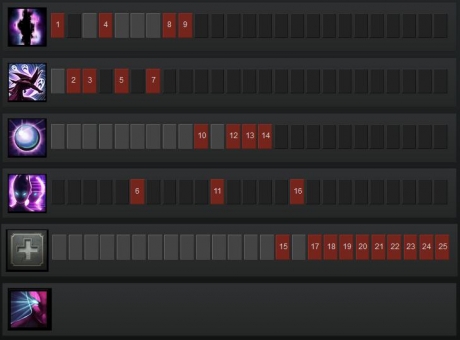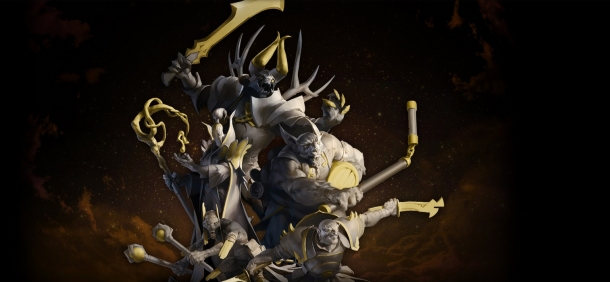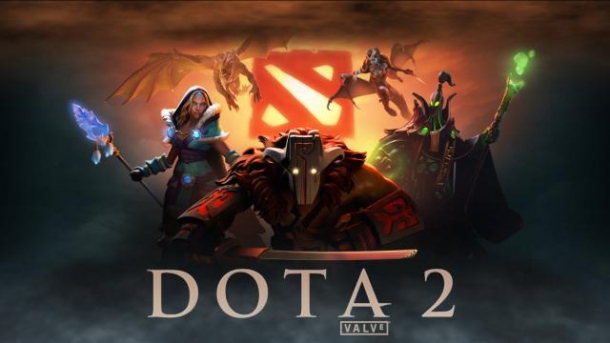 Introduction
Introduction
“From another dimension, a world beyond.”
Spectre is a melee agility hard carry. Whilst she is a late-game monster, capable of potentially destroying whole teams, Spectre is a very greedy carry who requires immense amounts of farm in order to fulfil her late game potential. For this reason she is a relatively unpopular pick outside of competitive Dota.
Competitively, however, Spectre remains a popular pick-up, not just because of her late game carrying potential but because her ultimate gives her global initiating and teamfight potential, allowing the team’s carry to effectively farm on one side of the map before instantly teleporting into the teamfight on the other side of the map should an engagement break out.
You can find our complete character profile for Spectre here.
Pros & Cons
Pros
- Late game monster
- Global presence
- Good chaser
- Decent escape mechanism
- Pure damage
Cons
- Needs a lot of farm
- Fairly useless early game
- Also fairly squishy early game
- No creep clearance ability
- Requires good game sense and map awareness
- Will find it almost impossible to farm without being babysat
Item Build
 Starting Items
Starting Items
There are a couple of different starting builds for Spectre. In public matchmaking you’re likely to face a certain degree of pressure on the lane (in contrast to most professional safe lanes) and so a build that errs on the safe side, like the one in the image on the right, is advisable:
- A set of Tangos, a Healing Salve, a Stout Shield, and 2x Iron Branches.
This gives you plenty of starting regen, which should see you through the early laning stage, a Stout Shield to block harass, and Iron Branches to give you some starting stats.
Alternatively, if you’re confident that either you’ll be facing up against an easy offlane opponent or that your team can keep you well protected in the lane, you can swap the Stout Shield out for a Quelling Blade, and get an extra Iron Branch. This is a greedier starting build but will make last hitting easier.
Early Game
Upgrade any Iron Branches you purchased at the start into a Magic Wand. It’s also acceptable to upgrade your Stout Shield into a Poor Man’s Shield in the early going, although it’s entirely optional.
Grab basic Boots of Speed as quickly as possible, and start working towards your upgraded boots of choice. These can be either Power Treads (stats, defensive), or Phase Boots (damage & chase, offensive).
All of the above can be bought from the side shop (except for the Magic Wand recipe, which you’ll need to get the Courier to deliver), so there’s no reason to leave the lane except to dodge an expected gank, in which case you may be able to clear the nearest jungle camp if you feel it’s safe.
Now is the time to decide whether you want some early tank items in case of an action-packed game where you’re forced to fight early. If so, popular options are Drums of Endurance (good stats, cost effective, easy to build into) or Vanguard (health infusion, health regeneration). Vanguard went out of favour for a long time but it’s somewhat returned to popularity on Spectre in recent months.
On the other hand, if things are going perfectly, you could consider a Hand of Midas, although it’s not particularly advisable; Spectre takes long enough to come on-line as it is, let alone trying to fit in a Midas pick-up before getting any utility items.
Core Options
Spectre is generally regarded as having three core damage options. Note that although I call them options, Diffusal Blade and Manta Style are good luxury pick-ups as well eve if you don’t opt for them as first items, although Radiance is not; if you don’t intend to rush it first then don’t get it at all.
Radiance – The greediest and riskiest build option. Only go for this if you get completely uncontested free farm and have a good last hit rate (or manage to net some early kills). Radiance is fantastic on Spectre because your Haunt illusions acquire the burn aura, making you a monster in teamfights and hell on earth for the enemy supports who will take a huge blow from your illusions alone. It also rapidly increases your farm and item progression thanks to the speed with which you can clear jungle stacks and creep waves.
The downsides are huge though: Firstly, you’re essentially forcing your team into a 4 v 5 situation until you get your Radiance up and running, and even then you’ll be extremely fragile. If the enemy team forces early teamfights or pushes your team is probably going to get run over before you come on line.
Secondly, if you die you’re going to be hit hard and set back a long way, because a big chunk of your gold will be from last hitting creeps and will thus be unreliable. If you die just before you’re able to afford your Sacred Relic it’s going to be a huge blow.
Diffusal Blade – The ‘cheap’ option. Diffusal is fairly easy to build into thanks to it having 4 relatively affordable pieces that can be bought whenever you have unreliable gold to spend. It doesn’t give you any survivability, but it’s a good middle ground between the two extremes of Radiance and Manta Style – you significantly buff your Haunt damage output without breaking the bank.
Even with the other builds Diffusal is almost always purchased. It gives you a nice chunk of agility and mana, and the mana burn will make life hell for enemy heroes, especially supports, because your Haunt illusions will also benefit from it. The active is also great for offensive chasing purposes and defensively purging enemy debuffs (such as Dust or a slow).
Manta Style – Good stats for an agility carry, increased mobility and attack speed, and most importantly 2 illusions every 50 seconds. This is useful not just for quickly pushing out lanes and taking down enemy buildings but also for dodging certain silences and projectile attacks/stuns, making you much harder to lock down.
Once you have your Manta you don’t need to fear being Orchid’d and silenced or Dusted; you can simple pop your illusions to dispel both effects.
Luxury Items
Butterfly – The ultimate late-game luxury purchase for agility carries – huge chunks of attack speed, damage, and evasion. It makes you much tankier and more dangerous, and significantly buffs your Haunt and Manta Style illusions in the process.
Heart of Tarrasque – Spectre is a good candidate for tank items like Heart of Tarrasque thanks to her Dispersion passive, which reflects damage taken. With a huge chunk of health and incredible health regeneration there aren’t many heroes who’ll be able to stand toe-to-toe with you once you start factoring in Dispersion. That said, you do need more direct damage items first, so it’s mid-ranking luxury item.
Daedalus – All-in damage build. Very high damage and a chance to Critical Strike. Not usually picked up on Spectre until she’s becoming six slotted.
Abyssal Blade – A nice chunk of health and damage, but most importantly two additional forms of lockdown that go through Spell Immunity – an active ability that will give you 2 seconds of stun and a passive that gives you a 25% chance of a 1.4 second stun.
Situational Items
Crimson Guard – A good defensive/utility item. If you decide to opt for an early-ish Vanguard then later upgrading it into a Crimson Guard is a good way of buffing your inventory in the late game when Vanguard’s usefulness tapers off and inventory slots are at a premium.
So you get a nice chunk of flat health (250), +2 all stats, +5 armor and 6 health regeneration. On top of that you gain a passive Damage Block ability, which gives an 80% chance to block 20-40 damage, and an active Guard ability, which allows you to create a shield which applies to yourself and allies in a 750 unit radius that grants everyone affected by it +2 armor and a 100% chance to block 50 damage.
Blade Mail – Blade Mail is very situational. It’s somewhat popular in competitive Dota, and if you have a poor game it can sometimes be the most cost-effective item to get which helps prevent you feeding. Especially highly recommended when facing off against low health enemies with strong damage over time abilities (Tinker is particularly susceptible to Blade Mail).
Black King Bar – Spectre doesn’t typically buy BKB, but sometimes it is necessary; if you find you’re being shut down in teamfights and unable to get in attack range you’ll need the Spell Immunity from BKB to be able to make an effective contribution to teamfights. That said, you ideally do not want to purchase this; it will seriously delay your item progression, which is already lengthy enough as it is, being a hard carry.
Boots of Travel - Boots of Travel are great for the late game, when you need to free up a slot which would otherwise be taken up by a TP Scroll. With this, you combine your Boots and TP Scroll slot into one, allowing you to put a slot to better use.
Skill Build
 Spectre has a couple of popular skill builds. The two most common are: 1) max Desolate followed by max Spectral Dagger. Or 2) Max Spectral Dagger followed by max Desolate. Some people swear by option 1, others by option 2. There’s not much in it, and both are entirely fine (a max Dispersion first build is really not recommended at all, however), so although the image above shows Desolate followed by Dagger, don’t consider it compulsory by any means.
Spectre has a couple of popular skill builds. The two most common are: 1) max Desolate followed by max Spectral Dagger. Or 2) Max Spectral Dagger followed by max Desolate. Some people swear by option 1, others by option 2. There’s not much in it, and both are entirely fine (a max Dispersion first build is really not recommended at all, however), so although the image above shows Desolate followed by Dagger, don’t consider it compulsory by any means.
Spectral Dagger is Spectre’s only true nuke ability. It shoots a Spectral Dagger at a chosen target or in a chosen direction. Any units hit by the Dagger are dealt a small amount of magic damage and are slowed. Any units that walk onto the trail left behind are also slowed. On top of that when Spectre walks along the trail she is granted bonus move speed and she can move across otherwise impassable terrain.
Because of its use as a long range nuke (it has a range of 2000 units) and an escape mechanism (you can fire it into a tree line and take cover there in a pinch), it is always skilled first. Whether you choose to max it first or second is up to you; the damage increase is fairly minor with levels, but the additional bonus to move speed and enemy slow makes it viable to max first if that is your inclination.
Desolate is one of Spectre’s two passive abilities. It is either maxed first or second, depending on personal preference (I prefer to max it first, personally). An offensive aura, it allows Spectre to deal bonus pure damage when she attacks an enemy hero, providing that hero has no nearby allied units within a 325 unit radius.
The bonus damage from Desolate is actually pure damage, so providing the enemy hero being focussed is not stood next to any allied units they will find it very difficult indeed to stand toe-to-toe with Spectre unless they have a significant farm advantage. This is what makes Spectre a great 1-on-1 hero.
Dispersion is Spectre’s other passive ability, and is the one which makes her a superb late-game tank. So although it is always recommend that you skill and max it last, it is still an incredible ability in its own right. Dispersion reflects a percentage of the damage Spectre would otherwise take from attacks/abilities back onto the units that cast them.
In effect, Dispersion gives Spectre incoming damage reduction which is then dealt back to the source. Early in the game this is fairly useless – a mere 10% damage reflection and a base health pool of just over 500 makes it ineffective. However, later on, when Spectre has a decent health pool, some items, and level 4 Dispersion, she gains 22% percent effective damage mitigation which will be applied back on the enemy. It is not uncommon for a late game Spectre to net multiple kills merely from tanking attacks, let alone actually dealing damage herself.
Haunt is always skilled (levels 6, 11 and 16). When cast it triggers 5 uncontrollable illusions which instantly attack the enemy team. They last for 5/6/7 seconds, dealing 30% of Spectre’s own damage with each attack, and at any point Spectre can take the place of one of these illusions.
This is the ability that gives Spectre global presence. Not only will the illusions by themselves deal significant damage to the enemy team if Spectre is farmed, as well as create a lot of confusion and chaos, but Spectre can also jump into one of the illusions at any time during the ability’s duration, allowing her to take part in teamfights even if she is on the other side of the map.
Gameplay Tips
 Spectral Dagger grants Spectre the ability to move across impassable terrain so long as she moves along the path left by the Dagger’s trail. This allows you to use it for escape purposes, to hide in areas that are inaccessible to most heroes in the game. Note, however, that if you move off the path you only get 2 seconds of collision avoidance; after that you will be stuck in place unless you have an alternative escape mechanism (such as a Tp Scroll).
Spectral Dagger grants Spectre the ability to move across impassable terrain so long as she moves along the path left by the Dagger’s trail. This allows you to use it for escape purposes, to hide in areas that are inaccessible to most heroes in the game. Note, however, that if you move off the path you only get 2 seconds of collision avoidance; after that you will be stuck in place unless you have an alternative escape mechanism (such as a Tp Scroll).
| Tip: Spectral Dagger actually grants vision along its path, so you can use it to potentially scout 2000 units into fog, in case you’re concerned about the possibility of an incoming gank or wish to, for example, scout out an enemy Roshan attempt. Remember too that even if an enemy becomes invisible they will leave a dark trail behind them, giving away their movements. |
The damage dealt by Desolate is pure damage, but it only takes effect if the enemy in question is not nearby allied units. This, combined with Haunt and Spectral Dagger, allows Spectre to get involved in early pick-offs though – if an enemy manages to escape from your teammates on low health you can cast Haunt, Dagger them if necessary, and finish them off with right clicks, which will be augmented by Desolate.
| Tip: It is advisable to always have a TP Scroll when playing Spectre. This will allow you to Haunt much more aggressively, for example to net a kill on an enemy on low health that is deep within enemy territory. You can jump to the Haunt, quickly finish them off, and then TP out to safety. If you do this without a TP Scroll you risk over-extending and being caught out. |
Dispersion is what allows Spectre to tank in the late game whilst simultaneously dealing high amounts of damage. In this respect she is similar to Bristleback, who deals significantly more damage if he is attacked. This is one of the key reasons items like Heart of Tarrasque and Butterfly are great on late-game Spectre.
Remember that the damage returned by Dispersion is based not just on a percentage of incoming damage but also on the distance the enemy is from Spectre; the closer the enemy is to Spectre the more damage they will have returned. If they are outside of a 1000 unit radius the damage will not be returned.
Although Haunt’s 5/6/7 second duration may sound high on paper, it is a very difficult skill to use effectively in the heat of actual gameplay. To use Spectre effectively you need to have excellent map awareness, and the ability to scout out enemy units quickly, assess their situation, and decide who (or indeed whether) to jump on. Poor use of Haunt will put you at immense risk. Good use of Haunt will allow you to pick off enemy heroes with ease.
Note that Spectre’s Haunt illusions do gain the bonus damage from her Desolation passive, however they do not gain the passive benefits of Dispersion.
Haunt is a great way of making a teamfight a 6v5, or even 7v5 engagement. If you know you have buyback you can wait until you die before popping Haunt and then rejoining the fight. This can be game deciding if used in the correct circumstances.
Last Updated - Patch 6.82c.


